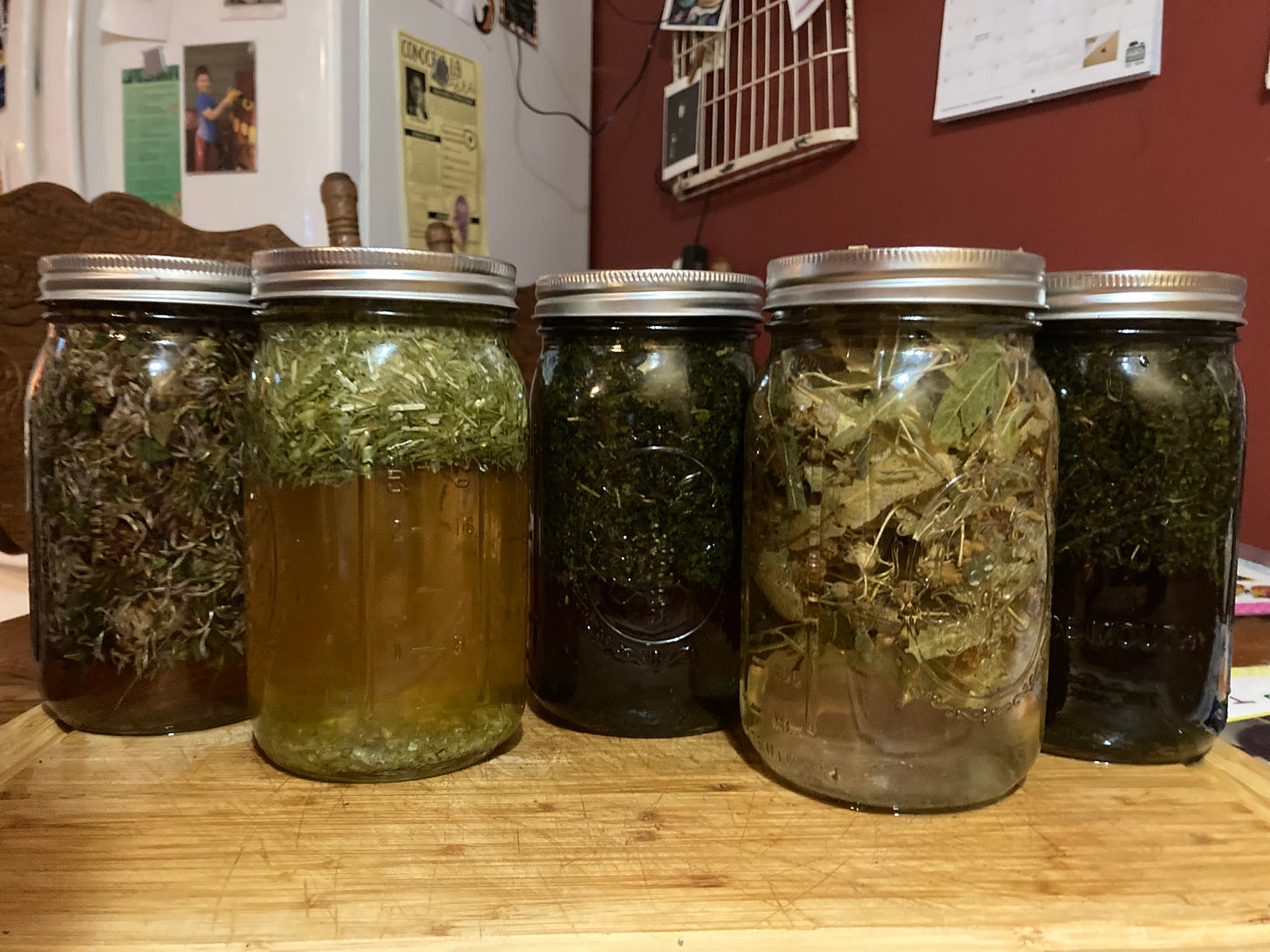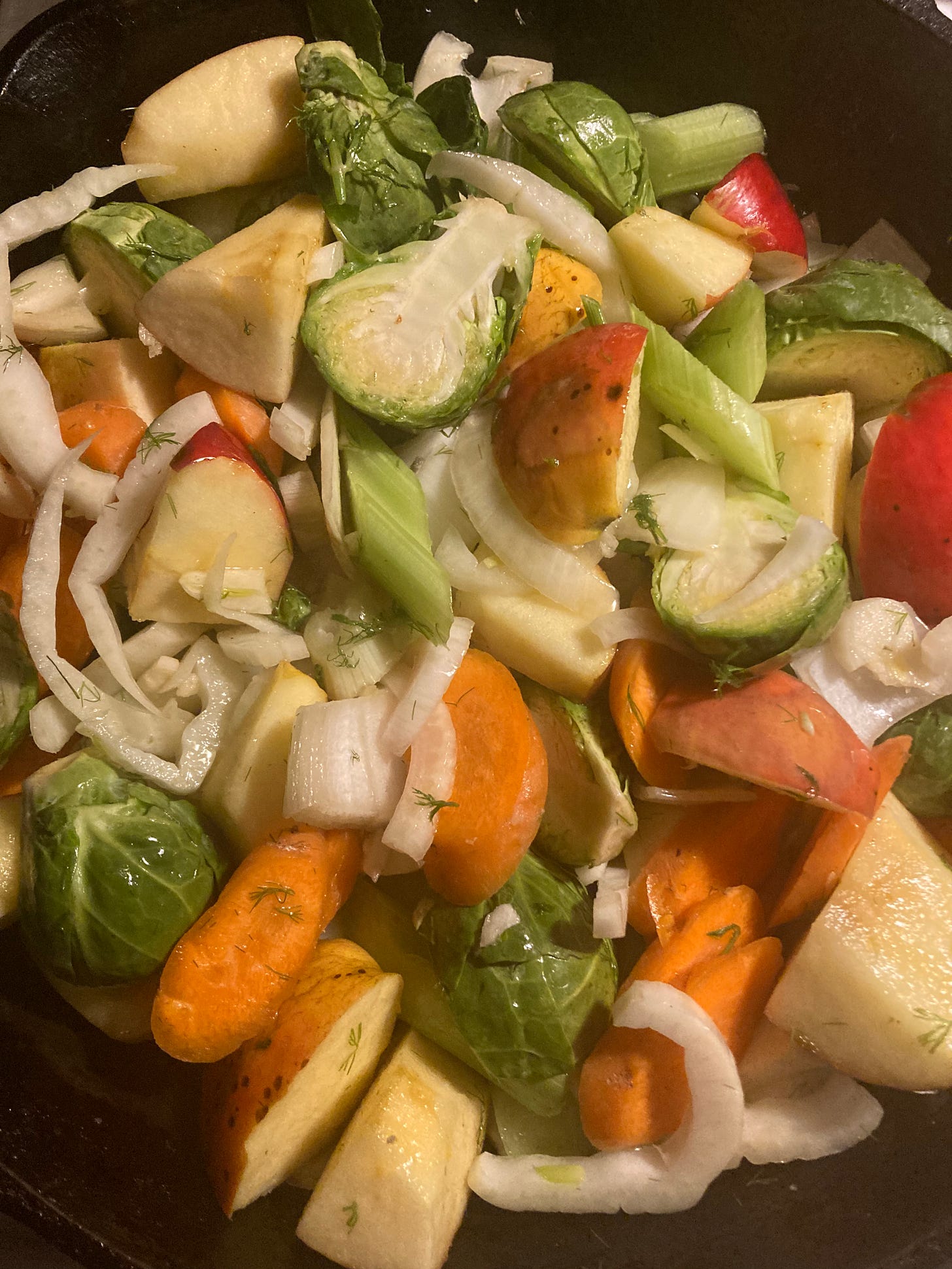Nutrition and Gut Health: Part II
Fermentation! Herbs! Here's a follow up to Part I, in which I dig into more specific remedies and allies for a happy gut.
We all know about the gut micro-biome. This diverse community of micro-organisms living within us, right? Well, have you thought about how important this community is to your health, and happiness? Perhaps so, and you are well on your way to increasing the health of this community within. Perhaps we are aware of its importance and take an acidophilous capsule now and again and eat some yogurt or drink kombucha. All fine things to do, but let me tell you, this is the tip of the iceberg.
Fermented foods are foundational in cultures across the globe. From kefir to tokosh (fermented corn or potato porridge found in the Peruvian Andes) to kimchi and miso, we find fermented foods embedded in everyday life. If we trace our ancestral food ways back in time we most likely will find that our relatives also made a variety of fermented beverages, cheeses, meats, or vegetables. If you have never fermented anything before, this may seem intimidating, but it’s all fairly simple, and bringing in just one or two of these foods into our daily diet can make a huge impact.
Hawthorne berries
This will not be a tutorial on how to make these food items. There are many wonderful resources out there for that. But I wanted to encourage anyone reading this to try it out, because it’s fun and brings that extra layer of health and resilience to anyone’s life. Sure, you can buy most of this stuff at the store and let’s also be aware that a lot of us are already consuming fermented foods regularly. Beer, wine, cheese, yogurt, sourdough bread, chocolate, coffee; all fermented. However, when I heard one of my teachers say that the benefits really come from making your own and utilizing the wild bacteria in your ecosystem, I knew it was true. To be resilient, we need the diverse array of bacteria from where we are.
Apples ready for baking
At present, my go-to is sauerkraut and “wine” or fruit and flower ferments, such as hard apple cider and dandelion wine. These are my “staple ferments,” that I make consistently. At other times I’ve made yogurt, kombucha, kimchi, fermented veggies, sourdough bread, and fermented porridge. I’m already feeling more inspired writing this, to try something new again. However, life can get busy, and it’s nice to have one or two items that you get to know more deeply, that come easily to you, and that you enjoy. I wasn’t very good at making yogurt. I loved it when it turned out but I had a lot of results I wasn’t happy with. I decided that for now, making yogurt is not going to be my thing. I will buy that but commit to the sauerkraut. At any rate, I encourage you to experiment, but not get discouraged or overwhelmed, because there is a learning curve. I think it’s fun to try lots of different things, and if you get the fermentation bug this can be very rewarding. But for practicalities’ sake you don’t have to make ALL your own stuff. What calls to you? And again, what did your ancestors eat?
Nourishing herbal infusions
If making ferments is not your thing, or if you are already seasoned in that department, another fun way to diversify your gut bacteria is by getting dirty! Yes, roll around in the dirt, eat dirt, make a mud pie. Ok, not literally perhaps, but sort of. Gardening has shown to bring the benefits of soil bacteria into our guts. Try doing some of your gardening without gloves and get some dirt under your fingernails. We know that ultra-hygienic homes cause more allergies for children. That hand cleansers and sanitizers increase the prevalence of super-bacteria (not the good kind). Kids who grow up on farms with animals are sturdier than kids in sterile environments. Seems obvious, doesn't it? Yes, even a little fecal contamination here and there can actually make you stronger, not sick! Our access to healthy bacteria has decreased in recent years, and the pandemic has increased use of disinfectants. These have their place, but then it’s even more important to bring in the healthy bacteria our bodies need to thrive. Potted plants in soil, a pet in the home, some time outdoors barefoot, or eating a wild leaf are all simple ways we can cultivate our micro-biome. Chickweed, dandelion, violet, plantain, are all wild weeds that grow pretty much everywhere, including city planters. See if you can identify one or more of these and take a nibble. One leaf a day could give you all the soil bacteria needed for a healthy gut. Just don’t wash it first!
Slippery elm balls
I want to get into other remedies for soothing and strengthening our gut when things seem really out of whack. A lot of people are experiencing more stress which can make it more difficult to prepare healthful foods, which gets us feeling more yuck, well, as you see, it’s a cycle that keeps going round. Where to start? For anyone that is in distress with their gut I would suggest beginning with soothing and anti-inflammatory herbs. For increasing digestion and dealing with issues like gas and bloating there are also wonderful aids in the herbal world. Let’s check some of them out:
Slippery Elm. This is my number one gut soothing herb. Slippery Elm is the inner bark of a tree and when you add water it gets slippery! Like goo. What it does is multi-fold. It soothes the intestinal lining of the gut from end to end, calming inflammation. It also nourishes this lining and helps move along any unwanted substances. I buy it in powdered form. You can mix it with honey to a pie dough consistency and shape into little balls that can easily be stored and sucked on throughout the day. Check Susun Weed’s YouTube channel for a video of how to make Slippery Elm balls.
Comfrey Leaf. As an infusion, comfrey has a soothing effect on the gut and digestion. Taking small sips and gradually incorporating this herb into your daily infusion rotation may be all you need to do for calming and nourishing your gut. Comfrey is especially adept at rebuilding all mucous membranes in the body, and is highly nutritious. Check my post on making infusions to learn more.
Marshmallow Root. I make this into an infusion and sip throughout the day without straining. Cold water can then be added up to three times for extracting more of the mucilaginous qualities. Seeing a trend with these herbs? Yes, slippery, slimy, and mucous loving herbs are very helpful to our gut.
Dandelion. In any form, dandelion will improve digestion. Ways I love to prepare dandelion include as a sauteed green, root tincture, vinegar of the whole plant chopped up, and the flowers as a tea. All make wonderful remedies for a happy tummy. The key with dandelion is to take some before your meals and to keep this going consistently for some time. Dandelion increases the production of hydrochloric acid in the stomach and is a liver nourisher. It has the ability to reduce acid reflux, calm nausea, and reduce gas. Also, dandelion is an herb of joy. She will help you feel better, happier, and more in touch with the joy in your life, if you allow.
Aromatic seeds. Fennel, anise, cumin, coriander, cardamom are all aromatic seeds, that made into a tea can calm an upset gut or stomach. They reduce gas and bloating and work really fast. Just place a small spoonful in a cup and add hot water. Sip as needed before it cools.
Motherwort. Not usually seen as a digestive aid, it is an extremely helpful herb to our nervous system. In the mint family, motherwort is bitter and a heart helper. In fact, I recently learned motherwort has been shown to reduce cancer as well! All mints will help improve digestion. If you love mint tea, or rosemary, or sage these will all help. Motherwort made into a tincture, using the fresh flowering tops is known to relieve anxiety. It can be taken as frequently as needed, and even just a few drops can do the trick. Keep this herb on hand if you find your digestive upset linked to stress and anxiety.
One final important component to gut health are prebiotics. For these to benefit us, we already must have a healthy and thriving gut biome. However, prebiotics add a critical component to our health by feeding those bacteria and keeping them happy. They tend to be in foods that are high in fiber, as well as inulin and pectin. Brown rice, starchy root vegetables, leafy greens and lettuces, apple sauce, and herbs like hawthorne berry, elecampane root, dandelion root, burdock root all contain these substances. When you make an herbal preparation that is high in inulin it will appear as a thick whitish liquid in the bottom of the jar. Yumm, bacteria food!
I hope that fermentation becomes a favorite pastime for you. The research alone can be fascinating. There are even pubs and restaurants now that are in celebration of fermented foods and offer a vast array of things to try. Have fun, feed that gut, and remember, about 80% of serotonin is made in the gut, so when you feed your healthy gut bacteria, you really are feeding your happiness.
Enjoy!
Veg mix ready for the oven
Resources:
Wild Fermentation | Fermentation makes foods more nutritious, as well as delicious! :: Wild Fermentation
Herbal Women Classroom Courses (podia.com)
Giulia Enders | Speaker | TED
Digestion: SWS-1067 The Susun Weed Show 2012 09 ~ 05 TMRN Presents: - YouTube
Slippery Elm Balls with Monica Jean - YouTube









